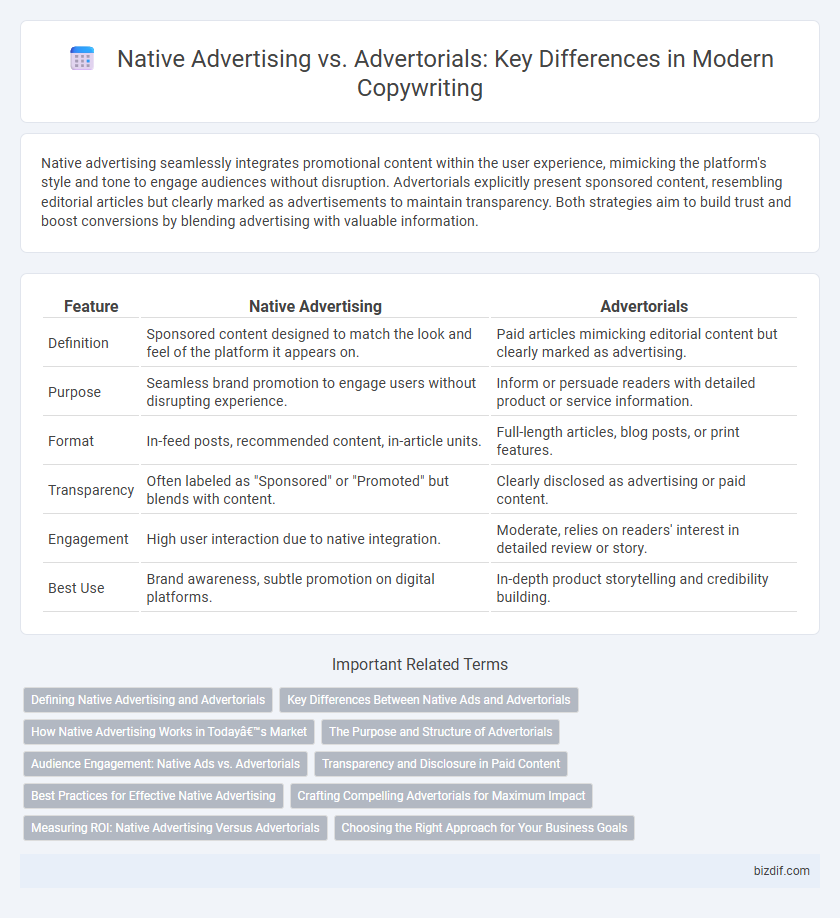Native advertising seamlessly integrates promotional content within the user experience, mimicking the platform's style and tone to engage audiences without disruption. Advertorials explicitly present sponsored content, resembling editorial articles but clearly marked as advertisements to maintain transparency. Both strategies aim to build trust and boost conversions by blending advertising with valuable information.
Table of Comparison
| Feature | Native Advertising | Advertorials |
|---|---|---|
| Definition | Sponsored content designed to match the look and feel of the platform it appears on. | Paid articles mimicking editorial content but clearly marked as advertising. |
| Purpose | Seamless brand promotion to engage users without disrupting experience. | Inform or persuade readers with detailed product or service information. |
| Format | In-feed posts, recommended content, in-article units. | Full-length articles, blog posts, or print features. |
| Transparency | Often labeled as "Sponsored" or "Promoted" but blends with content. | Clearly disclosed as advertising or paid content. |
| Engagement | High user interaction due to native integration. | Moderate, relies on readers' interest in detailed review or story. |
| Best Use | Brand awareness, subtle promotion on digital platforms. | In-depth product storytelling and credibility building. |
Defining Native Advertising and Advertorials
Native advertising integrates promotional content seamlessly within the platform's natural user experience, matching the look, feel, and function of the surrounding media. Advertorials, on the other hand, are explicitly labeled advertisements designed to resemble editorial content but maintain a distinct separation from genuine articles. Both formats aim to engage audiences without overtly disrupting their browsing, yet native ads prioritize blending in while advertorials emphasize informative persuasion.
Key Differences Between Native Ads and Advertorials
Native advertising seamlessly integrates promotional content within the platform's natural user experience, matching the format and style without overtly disrupting engagement. Advertorials, presented as standalone editorial content, often explicitly disclose their commercial intent while resembling traditional articles or features. The key difference lies in user perception and placement: native ads blend into content streams, whereas advertorials occupy a distinct space designed to inform or persuade with marked branding.
How Native Advertising Works in Today’s Market
Native advertising integrates promotional content seamlessly within the user experience on digital platforms, making it less intrusive and more engaging compared to traditional ads. By matching the form and function of the surrounding content, native ads boost brand awareness and drive higher consumer interaction in today's market. Platforms like Facebook, Instagram, and native ad networks leverage data targeting to deliver personalized native ads that resonate effectively with specific audiences.
The Purpose and Structure of Advertorials
Advertorials are designed to blend advertising with editorial content, providing informative and persuasive messages that align with the publication's style and tone. Their structure typically includes a clear headline, engaging body copy that offers valuable information or storytelling, and a subtle call-to-action that encourages consumer response without overt sales pressure. The primary purpose of advertorials is to educate and build trust with the audience, making the promotional content feel less intrusive and more credible than traditional advertisements.
Audience Engagement: Native Ads vs. Advertorials
Native advertising seamlessly integrates brand messages within relevant content, enhancing audience engagement by matching the look and feel of the platform. Advertorials, often more formal and lengthy, deliver comprehensive product information but may experience lower interaction rates due to their overt promotional style. Data shows native ads achieve up to 52% higher engagement compared to traditional advertorials, making them more effective for capturing audience attention.
Transparency and Disclosure in Paid Content
Native advertising integrates paid content seamlessly within editorial environments, often requiring clear labeling to maintain transparency and comply with FTC guidelines. Advertorials explicitly mimic editorial articles but must disclose their promotional nature prominently to avoid misleading readers. Both formats demand honest disclosure practices to build trust and ensure ethical advertising standards.
Best Practices for Effective Native Advertising
Effective native advertising seamlessly integrates branded content into the platform's editorial flow, maintaining relevance and engaging users without disrupting their experience. Employing clear disclosure labels like "Sponsored" or "Paid Content" enhances transparency while preserving trust and credibility. Crafting high-quality, valuable content that aligns with the audience's interests and platform tone maximizes interaction rates and drives meaningful brand engagement.
Crafting Compelling Advertorials for Maximum Impact
Crafting compelling advertorials requires blending persuasive copywriting with informative content that aligns seamlessly with the target audience's interests, enhancing engagement and trust. Leveraging storytelling techniques and clear calls-to-action within advertorials boosts conversion rates by providing valuable context while maintaining subtle brand messaging. Optimizing headline relevance and maintaining transparency ensures advertorials resonate authentically, differentiating them from native advertising and maximizing overall campaign impact.
Measuring ROI: Native Advertising Versus Advertorials
Measuring ROI in native advertising versus advertorials requires analyzing engagement metrics such as click-through rates, conversion rates, and time spent on content to assess audience interaction effectively. Native advertising often delivers higher ROI due to its seamless integration with platform content, enhancing user experience and generating more authentic engagement compared to traditional advertorials. Advertorials may have lower engagement but can excel in brand storytelling and targeted messaging, which should be factored into comprehensive ROI evaluations.
Choosing the Right Approach for Your Business Goals
Native advertising seamlessly integrates branded content within the user experience, enhancing engagement without disrupting audience flow, while advertorials explicitly present promotional messages styled as editorial content to build brand authority and trust. Selecting the right approach depends on your business goals: opt for native advertising to increase subtle brand awareness and drive organic user interaction, whereas advertorials suit detailed storytelling and direct response campaigns aimed at educating or persuading potential customers. Analyzing key performance metrics such as click-through rates, engagement time, and conversion success will help determine which format aligns best with your marketing objectives and target audience behavior.
Native Advertising vs Advertorials Infographic

 bizdif.com
bizdif.com